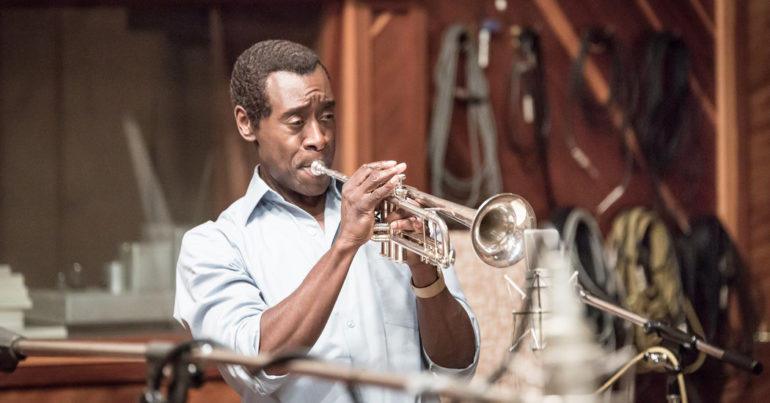“Don’t call it jazz, man. That’s some made-up word.” This is the advice given by Miles Davis (Don Cheadle) when journalist Dave Brill (Ewan McGregor) attempts to label his music as such (Davis’ suggestion? “It’s social music.”). Similarly, whatever you say about Miles Ahead, don’t call it a biopic. Clearly born of a deep passion for Davis’ music, Miles Ahead takes inspiration from its subject by refusing to cleave to a template. (How anyone can want to stick to standard portrayals of musical lives onscreen after Walk Hard: The Dewey Cox Story skewered the whole genre is baffling). Yet for all its style and clear admiration, Miles Ahead is stuck in some kind of rut; it sticks to the tune for as long as it can tolerate, and then begins making up completely new notes. It’s daring, but the tune ends up sounding awkward and choppy.
Putting the lives of musicians on film comes with a great degree of prestigious and structural baggage, often seen as a quick way towards awards glory and acclaim. The formula (Early days, success, excess and redemption are covered, in that order) works to a point, but the most memorable films of this ilk are the ones that break the mould. From Amadeus to I’m Not There., musical genius requires filmmaking genius to match. Thus, Cheadle has saddled himself with a particular challenge for his debut behind the camera. We’re introduced to Davis in the film in his retirement of the mid-1970s. More specifically, we’re watching him and Brill being chased down a New York street by an oncoming car with a handgun poking out the window. The concept behind Miles Ahead is a portrayal of Davis as a gangster-like figure, with this particular ‘70s-set foray portraying him as a particularly mean and vicious down-and-out. In the title role, Cheadle immerses himself in the part from the first frame, unafraid to grapple with the abrasiveness and drug-fuelled paranoia that defined Davis in the late 1970s. Of course, this is just half the story. Try as Cheadle might, he is ultimately forced to recourse to flashbacks to the various stages of Davis’ life and career from the early 1940s to the early 1960s.
As reticent as Cheadle might be towards their conventionality, the scenes of Davis’ early career are when Miles Ahead works best. Scenes of Davis in the studio offer glimpses of an artist at once improvisational and in control. All the best art makes that which seems freeform seem effortless, despite the hard work that has gone into making it. Cheadle absolutely nails Davis’ passion whilst playing music, his ease when on stage, and his abrasiveness in most other aspects of his life. Miles Ahead takes care not to smooth its subject’s rough edges. The film boasts plenty of colour and energy, but never at the expense of Davis’ imposing character. Taking the brunt of his tumultuous behaviour is his first wife, Frances Taylor. In the role of Taylor, Emayatzy Corinealdi delivers a breakout performance. This woman gave up a lot out of love, but there is a refusal to paint her as a victim here. Corinealdi’s scenes with Cheadle are the film’s highlights; on this evidence, one can only wish this material might be revisited to present a George-and-Martha-alike standoff. Their moments are when Miles Ahead feels most engaging, not least because these scenes are its most honest.
In the ‘70s segment, Davis finds Brill on his doorstep one morning looking for an interview. A punch to the face, some bumbling and a misunderstanding later, and Davis has Brill in tow to Columbia Records’ offices, pulling a gun on executives for not paying up a previously-agreed retainer. These events are a combination of fact (the retainer), hearsay (Davis’ temper) and all-out fantasy. Brill is a creation of Cheadle and co-writer Steven Baigelman, as is the vast majority of the ‘70s-set events. The eventual theft of a master recording of new material from Davis’ apartment sees Davis and Brill off on a Starsky and Hutch-aping cross-city jaunt to find the culprit (A weasley music producer, played by a miscast Michael Stuhlbarg). This combination of fact and fiction only serves to leave the viewer wishing for these two films and plotlines to be separated. One might have been conventional, and the other just plain odd, but at least they wouldn’t have ended up strangling each other. Miles Ahead’s structure is a manifestation of Cheadle’s commitment to Davis’ improvisational style. This isn’t a jazz biopic; it’s jazz fusion. It’s just a pity that the fusion of genres and plots doesn’t translate into anything approaching harmony.

